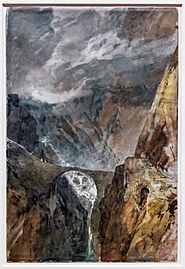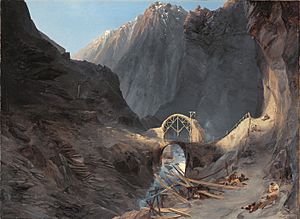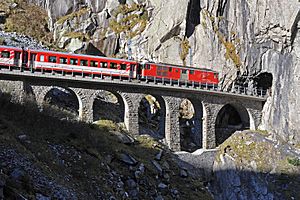Schöllenen Gorge facts for kids
The Schöllenen Gorge (also called Schöllenenschlucht) is a narrow valley carved by the upper Reuss River in Switzerland. It's located in the canton of Uri, between the towns of Göschenen in the north and Andermatt in the south. This gorge is a very important route because it leads to the famous St Gotthard Pass.
The gorge has very steep granite walls. Because of this, the road and railway that go through it need amazing bridges and tunnels. The most famous of these is a stone bridge known as the Teufelsbrücke, which means "Devil's Bridge."
Contents
What is Schöllenen Gorge?
How the Gorge Was Formed
The Schöllenen Gorge is a great example of a river valley carved by a river in the mountains. The Reuss River cut through the hard rock of the Aar massif (a large mountain block) over a very long time. You can see different types of rock layers at the southern end of the gorge. The Urnerloch tunnel, for example, goes right into this ancient granite rock.
History of the Schöllenen Gorge
Early Days
The name "Schöllenen" comes from an old language called Rumantsch, meaning "stairs" or "steps." Around the 12th century, this gorge marked the edge of where people from the Alemanni group settled in the Alps. It was also a border between different church areas.
Before bridges, getting through the gorge was very hard. People had to use a difficult footpath that went high up the mountainside to avoid the steepest parts. They even carved steps into the rock to help them climb.
Opening the Gotthard Pass
The gorge became much easier to cross around 1230 when a wooden bridge was built. This was a huge deal! It opened up the Gotthard Pass, which was a very important route for trade and travel across the Alps. This new path had a big impact on the region and even on the politics of the Holy Roman Empire in Italy.
The first path through Schöllenen included a wooden walkway called Twärrenbrücke. This walkway was attached to the rock wall. There was also a wooden bridge over the gorge, sometimes called "spray bridge" because of the water. People believe that the Walser people, who were skilled builders, helped create this amazing path. A local blacksmith named Heini from Göschenen is often given credit for building the bridge.
The Legend of the Devil's Bridge
In the past, a famous legend grew around the bridge, saying that the Devil himself built it! Many old bridges in Europe have similar stories. The name "Devil's Bridge" (Teiffels Brucken) was first written down in 1587.
One version of the legend says that the people of Uri asked the Devil for help to build the difficult bridge. The Devil agreed, but he wanted the soul of the first living thing to cross it. To trick him, the people sent a dog across first. The Devil was furious! He went to grab a huge rock to smash the bridge. But on his way back, a holy man "scolded him" and made him drop the rock. You can still see this rock near Göschenen today.
Another version of the story says a goat was sent across instead of a dog. And instead of a holy man, an old woman marked the rock with a cross, which made the Devil drop it and run away.
People think this legend probably started in the 16th century, maybe from travelers who misunderstood the name and then the story grew from there.
The Devil's Stone
The Devil's Stone (Teufelsstein) is a very large granite rock, about 12 meters tall and weighing around 2200 tons. It's located near Göschenen.
Over the years, this stone has had an interesting history. In 1887, it was even sold to a chocolate factory and painted yellow to advertise chocolate! Later, in 1923, there were plans to destroy it, but people worked to save it.
In 1970, the stone was again in danger of being destroyed to make way for a new highway. This time, many people wanted to save it. In 1971, the government agreed to move the stone instead of destroying it. This was a very expensive project, costing a lot of money. Some people thought the cost was too high and suggested spending the money on other things, like a retirement home.
Finally, in 1972, the stone was successfully moved 127 meters. It cost about 335,000 Swiss Francs. Today, you can see the Devil's Stone near the entrance of the Gotthard Road Tunnel, visible from both the railway and the highway.
Later History and Modern Bridges
The original wooden "spray bridge" was replaced by a stone bridge in 1595. This is the bridge that became known as the Devil's Bridge.
In 1707-1708, a new road was built, including a 60-meter-long tunnel called Urnerloch. This was the first road tunnel ever built in the Alps! After this tunnel was finished, the old Twärrenbrücke walkway was no longer needed and eventually fell apart.
In 1799, the gorge was the site of a dramatic battle during the Napoleonic Wars. The French army damaged the bridge as they retreated. This caused trade with Italy to shift to another mountain pass. A monument to the Russian general Suvorov was built near the Devil's Bridge in 1899 to remember this battle.
Modern Engineering Marvels
A second stone bridge was built between 1804 and 1830. This new bridge was designed by Karl Emanuel Müller and allowed cars to cross the Gotthard Pass. The old 1595 bridge was no longer used after this and collapsed in 1888.
Even though the main Gotthard Rail Tunnel avoided the gorge, a special rack railway called the Schöllenenbahn was built through the gorge in 1917. This type of railway uses a toothed track to climb steep slopes.
The modern road bridge and tunnel you see today were built in 1958. This route was very important for crossing the Central Alps for many years. However, since the Gotthard Road Tunnel opened in 1980, the Schöllenen Gorge road is now mostly used for regional travel, connecting Uri with other areas like canton of Valais.
See also
 In Spanish: Garganta de Schöllenen para niños
In Spanish: Garganta de Schöllenen para niños









